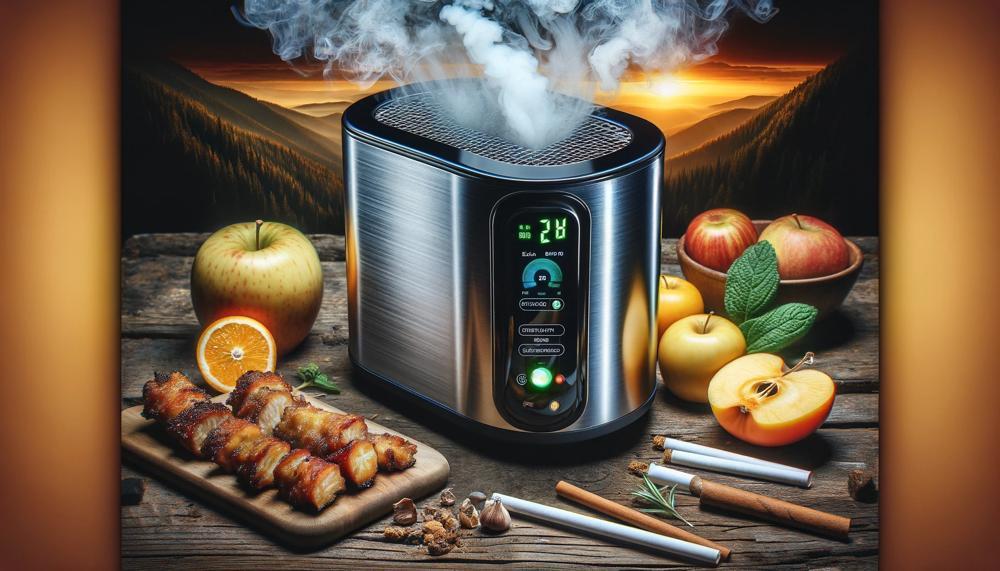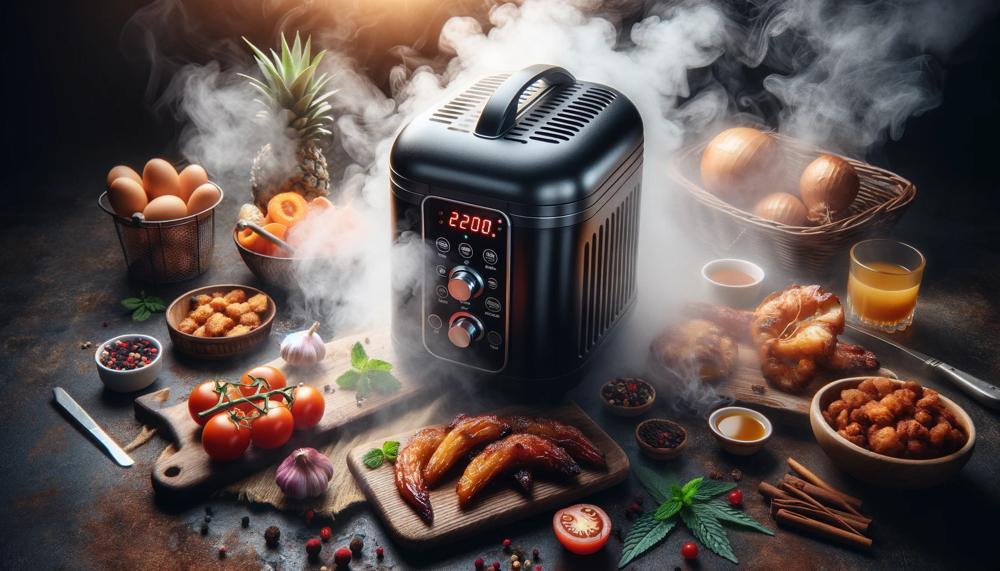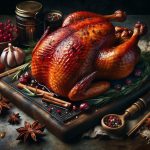Whether you’re a seasoned pitmaster or a novice eager to impress at your next backyard barbecue, getting that perfect infusion of smoky goodness into your meats isn’t just an art—it’s a science.
In this post, we’ll cut through the smoke and mirrors to provide you with straightforward, actionable advice that will elevate your smoking game.
Our focus will be on practical tips that can be implemented right away, ensuring every piece of meat you smoke is bursting with flavor.
Here’s a sneak peek at the golden nuggets of wisdom we’ll be sharing:
- Choosing the Right Wood Chips: Discover how the type of wood can dramatically alter the taste of your smoked meats.
- Prepping Your Meat: Learn the secrets to preparing your meat that will maximize smoke adhesion.
- Temperature and Timing: Understand the delicate balance of temperature and time to optimize smoke penetration.
- Water Pan Wonders: Find out how using a water pan can help in enhancing the smoke flavor.
By the end of this post, you’ll be equipped with the knowledge to not just use your electric smoker, but to master it, ensuring every meal is a smoky sensation.
So, let’s fire up that smoker and get ready to turn your average cuts into extraordinary feasts.
Contents
- 1 Electric Smoker Tips for Begginers and Experts
- 2 Ditch the chip tray
- 3 Don’t oversmoke your food
- 4 Smoke chicken on a hotter setting
- 5 Learn how to control temperature swings
- 6 For cold smoking, use the attachment
- 7 Control your vent position
- 8 Use foil on your grill racks to make clean up a lot easier
- 9 Don’t soak your wood chips
- 10 Pre-season your smoker before using it for the first time
- 11 Finish poultry in the oven for crisp skin
- 12 Conclusion
Electric Smoker Tips for Begginers and Experts
Achieving the best smoke from an electric smoker involves a blend of knowledge, experimentation, and attentiveness. Whether you’re starting your journey into smoking meats or you’re looking to fine-tune your techniques, the following guidelines will steer you towards smoky success.
Understanding Your Smoker and Prepping It Right
Before anything else, grasp the essence of your electric smoker’s operation. Seasoning or “breaking in” your smoker is not just a one-off task but a cornerstone for imbuing your meats with that coveted smoky zest.
Season your smoker:
Run it empty at a high temperature for about 2-3 hours, adding wood chips for the last 45 minutes to start building up that smoky residue on the inside.
Wood Chips: Type, Preparation, and Timing
| Factor | Advice | Impact |
| Wood Type | Opt for robust woods like hickory or mesquite for a bolder flavor. | Stronger woods impart a deeper smoky taste. |
| Soaking Chips | Avoid soaking; dry chips produce the clean, blue smoke you’re after. | Soaked chips lead to steam, not the desired smoke quality. |
| Replenishment | Keep an eye on the chip tray; replenish as needed to maintain smoke. | Consistent smoke leads to evenly flavored meats. |
Experimentation and Patience
Don’t shy away from trying new things. Each electric smoker has its quirks, and part of the joy is learning what works best with yours. For instance:
- Experiment with different woods and combinations thereof to discover unique flavors.
- Adjusting the amount of wood chips can help you find the right balance of smoke intensity.
- Consider a smoking tube filled with quality wood pellets for an extra smoke boost, especially if your smoker tends to be on the light side regarding smoke production.
Ditch the chip tray
Ditching the chip tray in favour of other innovative methods to generate smoke can offer your BBQ a distinct edge, imbuing meats with that sought-after, rich smoky flavour. Here’s a dive into alternative tactics, stepping away from the traditional and embracing the craft of smoking with zeal.
Alternative Smoke Generation Techniques
Smoker Box Method
Foil Pouch Method
Both these methods diverge from the conventional tray, opening doors to nuanced flavour profiles. Let’s delve into the specifics:
Smoker Box Method
Crafted from robust stainless steel or cast iron, the smoker box sits snugly over the electric smoker’s heating element.
This sturdy container withstands the heat while the wood chips inside smoulder, weaving a smoke that permeates the meat with a delicate, nuanced flavour.
Foil Pouch Method
The foil pouch offers simplicity and efficacy. By enclosing wood chips in a makeshift aluminium foil pouch and strategically piercing it, you allow for just the right amount of oxygen to fuel the chips’ smouldering. Positioned on the heating element, this method is akin to a slow dance of smoke and heat.
Wood Chip Varieties
Choosing the right wood chip type is akin to selecting the perfect seasoning for your dish. Here’s a quick guide:
| Wood Type | Flavour Profile | Best For |
| Hickory | Rich, bacon-like | Pork, Beef |
| Mesquite | Strong, earthy | Beef, Game |
| Applewood | Sweet, mellow | Chicken, Pork |
| Cherrywood | Fruity, mild | Poultry, Pork |
Adjusting Smoke Intensity
The beauty of these methods lies in their flexibility – a tweak here, an adjustment there, and you can tailor the smoke’s intensity to your heart’s desire. Whether you seek a whisper of smoke or a full-throated chorus, control is at your fingertips.
Don’t oversmoke your food
Understanding when you’ve oversmoked your food and preventing it from happening are crucial steps to mastering the art of BBQ. The essence of smoking lies in its ability to infuse meat with that sought-after smoky flavor, but too much of it can lead to a bitter, almost inedible outcome.
Let’s break down the signs of oversmoked food and how to keep your BBQ from crossing that line.
Signs You’ve Oversmoked Your Food
- Bitter Taste: The most telltale sign. If your meat tastes more like an ashtray than a delicacy, it’s oversmoked.
- Harsh Smell: Instead of a pleasant, mouth-watering smoky aroma, oversmoked meat emits a pungent odor.
- Dark Exterior: A dark crust is expected, but an overly thick, black layer indicates excess smoke absorption.
How to Prevent Oversmoking
The secret to avoiding oversmoking lies in moderation and control, focusing on wood selection, temperature management, and cooking time.
| Aspect | Guideline | Reason |
| Wood Type | Mix strong and mild woods | Balances flavor intensity |
| Temperature | Keep low and steady | Prevents rapid smoke absorption |
| Time | Monitor closely | Avoids prolonged smoke exposure |
Practical Tips to Enhance Your BBQ without Oversmoking
- Watch the Clock: Don’t just set it and forget it. Keep an eye on your smoking time to ensure it’s just right.
- Balance Your Woods: Experiment with wood types. Combine hickory or mesquite with cherry or apple for a nuanced flavor.
- Control Your Fire: A small, consistent fire provides enough smoke without overwhelming your food.
- Trial and Error: Each piece of meat is unique. What works for one might not work for another. Be prepared to adjust.
Ben, an aficionado in both construction engineering and grilling, often stresses the importance of learning from mistakes.
On his channel, he showcases how each BBQ session is an opportunity to refine your technique, emphasizing that mastering the balance between smoke and flavor is more art than science.
Remember, the goal of smoking isn’t to overpower your meats but to complement their natural flavors.
Smoke chicken on a hotter setting
Adjusting the temperature of your electric smoker for the perfect smoky chicken can seem a challenge, but it’s all about the balance.
Crispy skin, juicy insides, and a golden smoky hue are the hallmarks of a well-smoked bird. Let’s break it down into straightforward steps:
Setting the Right Temperature:
- Start High: Begin with a warmer environment than usual. Chicken thrives at around 275°F. This is a sweet spot for ensuring the meat is cooked thoroughly without drying out, and it helps in rendering the fat for crispy skin.
- Steady as She Goes: Aim to maintain this temperature consistently throughout the cooking process. Electric smokers are great for this, as they allow for precise temperature control.
Understanding Your Smoker’s Personality:
Each electric smoker is unique. Here’s how to get the best out of yours:
| Feature | Benefit | Action |
| Insulation | Keeps temperature stable | Choose a well-insulated model |
| Vent Position | Controls smoke density | Keep vent fully open for clearer smoke |
| Temperature Swings | Affects cooking consistency | Set slightly lower to accommodate |
Smoke Wisely:
- Wood Choice: Opt for wood that complements chicken, like apple or hickory. Avoid soaking chips; dry wood provides a purer smoke.
- Smoke Amount: Less can indeed be more. Overwhelming the chicken with smoke can overshadow its natural flavours.
Practical Tips for Best Results:
- Monitor Internal Temperature: Chicken should reach an internal temperature of 165°F. Use a meat thermometer for accuracy.
- Finish Strong: For that coveted crispy skin, consider a quick broil in the oven post-smoking.
- Trial and Error: Each smoking session is a learning curve. Note what works best for your setup.
By understanding your smoker’s quirks and following these guidelines, you’re well on your way to serving up delectable, smoky chicken that’ll have folks clambering for seconds.
Learn how to control temperature swings
To effectively control temperature swings in your electric smoker and ensure the best smoke for your BBQ, consider these refined strategies. The essence lies in diligent monitoring, precise adjustments, and strategic smoker management.
Here’s how you can achieve a steady temperature for that perfect BBQ smoke:
| Action | Purpose | Benefit |
| Monitor Temperature | Early detection of swings | Prevents drastic impacts on BBQ |
| Adjust Control Panel | Fine-tune temperature | Maintains desired heat levels |
| Minimise Door Opening | Retain heat and smoke | Ensures consistent temperature |
| Add Wood Chips | Continuous smoke supply | Stabilises temperature, enhances flavour |
| Use a Water Pan | Moisture and temperature control | Improves meat texture, regulates heat |
| Install a Gasket | Improve seal integrity | Minimises heat loss |
| Adjust Vent | Airflow management | Stabilises internal temperature |
By adhering to these strategies, you’re setting the stage for BBQ success. Remember, the key to mastering your electric smoker and the art of BBQ lies in patience, practice, and precision.
For cold smoking, use the attachment
For cold smoking with an electric smoker, the attachment plays a crucial role. It’s designed to adapt traditional electric smokers, which are typically geared towards hot smoking, to the nuanced, gentle art of cold smoking.
This method, beloved for its ability to impart smoky flavors without cooking the food, relies on smoke at temperatures usually below 30°C (86°F). Here’s how the attachment fits into the grand scheme of BBQ mastery:
Purpose and Functionality of Cold Smoke Attachment
| Feature | Description | Benefits |
| Cold Smoke Generation | Utilizes wood embers or pellets to produce smoke. | Allows smoke to infuse food with flavor without cooking it. |
| Temperature Control | Maintains smoke production at low temperatures. | Prevents food from cooking, ideal for cheeses, fish, and cured meats. |
| Wood Compatibility | Works with a variety of hardwoods. | Enables matching wood types to specific foods for enhanced flavors. |
Choosing Your Woods Wisely
When diving into the world of cold smoking, selecting the right wood is akin to choosing the perfect seasoning for a dish. Each wood variety imparts a distinct flavor.
For instance, applewood’s subtle sweetness is a match made in heaven for pork, while the robustness of mesquite complements the boldness of beef. It’s this meticulous pairing that elevates your BBQ from simply smoked to exquisitely flavored.
Cold Smoke Generators: The Unsung Heroes
Attachments like Shomehouse’s Smoke Chief and Smoke Daddy’s Big Kahuna transform your electric smoker into a cold smoking powerhouse.
These units, whether feeding smoke into the chamber or resting on the grates, are the linchpin in achieving that coveted smoky taste without the heat.
Control your vent position
Adjusting the vent position in your electric smoker is key to mastering the subtle art of smoke creation. Here’s how this manoeuvre impacts the overall smoking process:
- Oxygen Intake: The lifeblood of smoke production. Opening the vents increases airflow, fuelling the fire and intensifying the burn of the wood chips. This act, in essence, enhances the smoke’s richness and depth, which kisses your meat with that sought-after smoky flavour.
- Temperature Regulation: The dance of heat and cool within the chamber. With vents ajar, you invite a breeze, stoking the coals and elevating the temperature. A closed scenario, on the contrary, whispers a lull, calming the flames and dropping the heat. It’s a delicate balance, akin to the rhythm of the ocean, guiding the heat to kiss the meat just right.
- Smoke Flow: Directing the ballet of smoke. Open tops ensure the escape of old, stale smoke, ushering in the fresh, flavor-laden vapours. It’s a choreography between keeping the good and expelling the unwanted, ensuring your meat bathes in only the finest aroma.
Here’s how adjusting your vents can change the game:
| Vent Position | Oxygen/ Airflow | Effect on Smoke and Heat |
| Fully Open | Maximum Airflow | Increased smoke density and higher temperatures |
| Partially Open | Moderate Airflow | Balanced smoke flavour and controlled temperatures |
| Fully Closed | Minimal Airflow | Subtle smoke flavour and lower temperatures |
In essence, the vent position isn’t just a minor tweak; it’s the heartthrob of the smoking process. Just as a sailor reads the wind, a BBQ maestro reads the smoke – adjusting, adapting, and harnessing the power of the vents to craft a masterpiece.
Use foil on your grill racks to make clean up a lot easier
Using foil on grill racks in an electric smoker can significantly streamline the clean-up process, transforming what could be a tiresome chore into a straightforward task.
This simple yet effective strategy not only enhances the convenience of smoking but also ensures that your electric smoker remains ready for its next use without the need for extensive scrubbing or the use of harsh cleaning agents.
Below, we delve into the specifics of how foil use on grill racks aids in clean-up and maintains the smoker’s condition.
Ease of Cleaning
| Without Foil | With Foil |
| Food particles and grease accumulate directly on the racks, requiring intensive scrubbing and potentially the use of chemical cleaners. | Food particles and grease collect on the foil, which can be easily removed and disposed of, leaving minimal residue on the racks. |
| Stubborn residues may necessitate soaking racks in soapy water, increasing clean-up time. | The need for soaking is vastly reduced, as most residues are captured by the foil, preserving the rack’s condition. |
Protection and Maintenance of Grill Racks
| Benefit | Explanation |
| Longevity of Racks | Reduces exposure to moisture and acidic food elements, decreasing rust and wear over time. |
| Maintained Performance | Prevents build-up that can affect heat distribution and smoking efficiency, ensuring consistent results. |
Tips for Using Foil on Grill Racks
- Proper Application: Ensure the foil covers the racks snugly but allows for adequate smoke and heat circulation around the food.
- Puncture for Drainage: If desired, puncture holes in the foil to allow fat and juices to drain away, preventing flare-ups and maintaining a clean smoke environment.
- Heavy-Duty Foil: Opt for heavy-duty aluminium foil to withstand the heat and weight of the food without tearing.
In sum, employing foil on your electric smoker’s grill racks presents a nifty trick to keep your smoking sessions fuss-free and enjoyable.
Don’t soak your wood chips
Soaking wood chips before tossing them into your electric smoker might sound like a smart move, but here’s the rub: it’s not. Here’s why it’s a brisket-sized mistake.
| Myth | Reality | Impact on BBQ |
| Soaked wood chips smoke better. | Soaking delays smoking, as water must evaporate first. | Longer wait times for smoke, delaying that succulent, smoky flavour. |
| Moist wood chips add flavour. | Steam, not smoke, is produced, diluting the pure smoke taste. | Risks of off-flavours and less satisfying BBQ results. |
| Soaked chips burn slower, controlling temperature. | Interferes with temperature control, complicating cooking. | Uneven cooking and potentially drier, tougher meats. |
So, why exactly is soaking your wood chips a backyard BBQ faux pas? First off, soaking leads to steam. In an electric smoker, where the allure is precise temperature control and consistent smoke, introducing steam is like inviting a raincloud to your sunny picnic. Steam cools the coals and messes with your temperature, making it as unpredictable as British weather. And when you’re aiming for that perfect pull-apart tender brisket, temperature is everything.
Then there’s the matter of time. Soaked wood chips take their sweet time to start smoking since they’re too busy drying out. This not only prolongs cooking but can also lead to drier, less juicy meats. Imagine waiting hours for a smoke ring that looks more like a smoke dot. Frustrating, isn’t it?
Lastly, the flavour. The essence of BBQ is that rich, smoky flavour, like a hug from your favourite aunt. Soaked wood chips, however, can impart off flavours. Instead of your meat tasting like it’s been kissed by smoke, it tastes like it’s been slapped by steam.
Stick to dry chips in your electric smoker. They catch quickly, smoke predictably, and won’t dampen your spirits—or your meats.
Pre-season your smoker before using it for the first time
Pre-seasoning a smoker is like tuning a fine instrument before a grand performance. It’s not just a preparatory step; it’s an essential ritual to ensure your smoking sessions are not just good, but great.
- Purification: When your smoker arrives, it brings with it remnants of its birthplace – oils, dust, and odors from the manufacturing process. Pre-seasoning acts as a purifying rite, expelling these unwelcome guests.
- Familiarization: This process is your first dance with the smoker. It’s where you learn its rhythms, understand its heat patterns, and get comfortable with its character without the pressure of a full-blown BBQ session.
- Protection: Regular re-seasoning layers your smoker with a shield against rust and wear. Think of it as nurturing a friendship that gets stronger with time.
- Quality of Smoke: Just as a well-seasoned pan gives better flavor, a pre-seasoned smoker yields a superior smoke quality. It’s about giving your meats and veggies a stage to shine, unmarred by off-flavors or impurities.
- Preventing Off-Flavors: A smoker unseasoned is a canvas for creosote – a bitter, acrid residue that can taint your BBQ. Seasoning keeps this uninvited guest at bay.
Finish poultry in the oven for crisp skin

To achieve crispy skin on poultry using an electric smoker, finish the cooking process in the oven. Here’s a step-by-step guide:
- Smoke your poultry: Begin by smoking your poultry in the electric smoker at a low temperature to infuse it with flavor. Ensure it’s fully cooked internally but not crisped on the outside.
- Preheat your oven: While your poultry is in the smoker, preheat your oven to a high temperature, around 204-232°C (400-450°F), to prepare for the crisping process.
- Transfer the poultry: Once your poultry is cooked through in the smoker, transfer it to a baking tray and place it in the preheated oven.
- Oven-finishing: Allow the poultry to roast in the oven for 10-15 minutes, or until the skin reaches the desired level of crispness. Keep a close eye to avoid overcooking.
- Rest before serving: Let the poultry rest for a few minutes after removing it from the oven to ensure the juices redistribute, enhancing the flavor.
Table: Smoker vs Oven Finishing for Poultry
| Method | Temperature | Duration |
| Smoking | Low (93-121°C or 200-250°F) | Varies depending on size |
| Oven Finishing | High (204-232°C or 400-450°F) | 10-15 minutes |
Conclusion
Harnessing the full potential of your electric smoker transforms ordinary meats into smoky masterpieces, enveloping your culinary creations in a cloak of rich, nuanced flavors.
The journey from novice to pitmaster is paved with wisdom, from selecting the perfect wood chips that complement your meats, to mastering the delicate dance of temperature and timing for optimal smoke penetration. Discover the transformative effect of a water pan in adding moisture and enhancing smoke adherence, turning each meal into a symphony of flavors.
The art of smoking with an electric smoker is a canvas of experimentation and patience, where each choice, from wood type to vent adjustment, paints a unique stroke of flavor. Innovative methods like the smoker box or foil pouch offer new dimensions of taste, while the careful avoidance of common pitfalls like oversmoking ensures your feast remains a delight, not a lesson in charcoal.
Master the balance of smoke and heat, embrace the quirks of your smoker, and let the spirit of BBQ infuse not just your meals, but your life, with joy and deliciousness.






